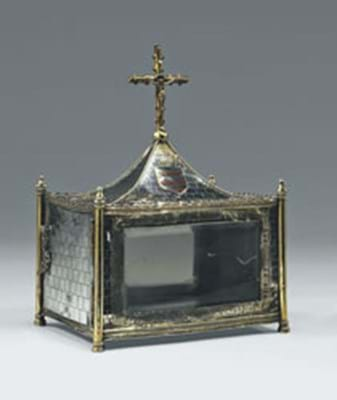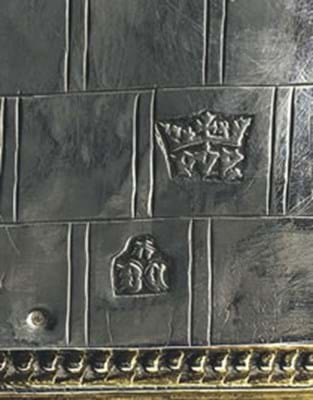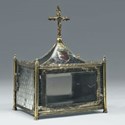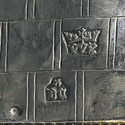Age wasn't the only rare feature to distinguish the rectangular lidded receptacle, which measures 93/4 x 7 x 5in (25 x 18 x 13cm). It also boasted a hallmark, for Le Puy, and a maker's mark BC and, thanks to a gilded inscription around the side and an enamel armorial to the cover, its provenance can be traced back to its original location and creation.
The inscription translates as On the first day of June in the year 1487 the present reliquary was given to Saint Clavel de Chamalieres by the great and powerful lord master Claude-Armant, Viscomte de Polignac. Polignac's arms are those on the cover and the reason he commissioned the casket is documented in local records.
When riding his blind mule past the Priory of Chamalieres-sur-Loire near the town of Le-Puy-en-Velay in the Haute Loire Polignac's attendants were praising the power of its relic of the holy nail from Christ's crucifixional cross.
He scathingly remarked that if the relic was that powerful let it restore the sight of his mule and he would believe in it. The mule's sight was duly restored but the Viscomte was blinded. Repenting his blasphemy Polignac prostrated himself before the relic promising a beautiful casket if his sight was restored. Polignac recovered his sight and the casket was duly made in Le Puy.
Setting aside the question of why someone as wealthy and powerful as a Vicomte should be riding a mule (and a blind one at that) it is a compelling tale.
The casket remained at Chamalieres until the early 19th century when it was sold , although the Priory seems to have retained the relic which is now preserved in the Cloister Museum of Le Puy Cathedral.
When the reliquary left the Priory it had later horn panels in the sides which have been replaced with glass at some point during its passage through various London and Paris salerooms and collections.
It entered the English family collection from which it was sold this month in the early 1960s. An earlier attempt to sell the casket at Sotheby's back in 1980 was unsuccessful but when it reappeared a quarter of a century on with an estimate of £60,000-80,000, there were several would-be purchasers in the room and on the phone.
The buyer was a Dutch private collector who paid £85,000 (plus 20 per cent premium).
• See pages 8 and 10 for a report on works of art sales in London.
Anne Crane
The Gothic tale of a blind mule and the holy nail
Medieval French silver is not a plentiful commodity. Much of it did not escape the great post-Revolutionary meltdown, but one piece that got away was the late Gothic reliquary casket that featured in Sotheby’s works of art auction in London on June 8.








